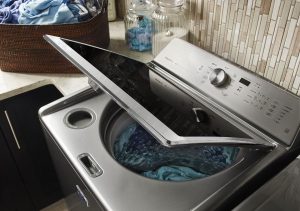1. Water Around the Machine:
The most obvious warning sign of a washing machine repair issue is water under your appliance. If there is a growing puddle of water, it could be a sign of a damaged water supply hose, seal or tub. Fortunately, these issues can be quite simple for a professional appliance repair specialist to resolve.
If you do see water around the machine, don’t ignore the issue, as you could not only allow the malfunction to develop into a serious fault, but also cause water damage to your home.
2. Dirty Laundry
It can be very frustrating when your laundry comes out of the machine and it isn’t spotlessly clean. But, it can also be an indication of an underlying appliance problem. The fault could be due to a malfunctioning part or sensor issue.
The first thing to check is that you didn’t overload the machine with laundry or use inadequate amounts of detergent. If this isn’t the case, you are likely to need professional help to diagnose the issue.
3. Strange Noises
You’re likely to be familiar with the gentle whirring and other soft sounds of your washing machine cycle. So, if the appliance starts to squeak or grind, it is a reason for concern.
Thumping noises are common when the machine is overfilled, as it causes the tub to be off balance. On the other hand, squeaking or grinding noises could indicate parts being stripped or a damaged component compromising performance. Unfortunately, these issues will not resolve themselves and if you ignore them, you could allow a catastrophic failure as the faulty part causes damage beyond repair.
4. Water in the Drum
When the load has finished, your clothes should be almost dry, as they have been properly rung out. So, if the clothing is sopping wet or there is water in the drum, there is a malfunction. While you can wring out the items by hand, this issue needs to be addressed, preferable before your next laundry cycle.
4. No Water
Conversely, if there is no water filling the drum when you turn on the machine, there is a major problem. You may be able to find a loose connection at the back of the machine, but in many cases, it is a sensor issue that will need the attention of an experienced pro.
Obviously, the washing machine cannot wash if there is no water, so you’ll need to switch off the appliance and make a repair call.
4. Error Codes
Finally, if you have a newer machine, it is likely to have a screen display. These models have sensors that work to offer efficient cleaning performance. If the sensors malfunction, it produces an error code, which will show on the display.
In some cases, you may find a reset for the error code in your owner’s manual. For example, if there is a small item such as a sock trapped in the filter, it may produce an error code. If you open up the filter and clear the blockage, it will reset the machine.
In most cases, the owner’s manual will direct you to contact a home appliance repair specialist to fix the code.
If you’re having issues with your washing machine, you can rely on the expertise of your home appliance repair technician to assist you.
